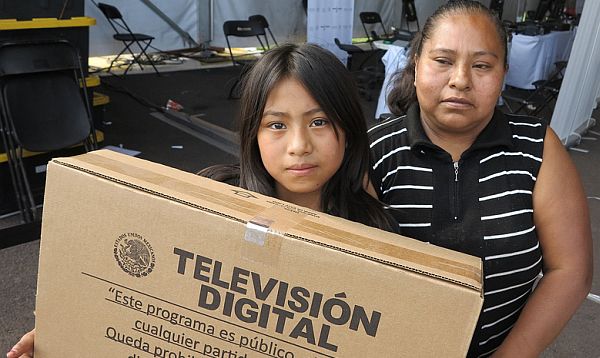Cradling a flat-screen television set in her arms, Tomasa Lopez beamed at her good fortune: She'd just taken part in the world's biggest distribution of free digital televisions.
Lopez, a domestic servant, was among thousands of people who've thronged a cavernous tent in the populous working-class Iztapalapa district, one of hundreds of venues across Mexico where the poor are receiving some of the 10 million digital television sets the government is giving away.
It's a program costing the Mexican treasury $1.6 billion in a push to convert the nation from analog television signals to a digital format. The U.S. made the switch in 2009.
"I am happy," Lopez said. "We've always wanted a digital television. We'll see more channels. The kids will see cartoons."
Other nations, such as Argentina, have given away digital television sets, but none on the scale of Mexico. Critics question why the government of President Enrique Peña Nieto is giving away 24-inch flat-screen televisions, each costing around $145, when decoder boxes that allow older analog televisions to remain in use — the U.S. solution — cost only about $40.
Television manufacturers clustered along Mexico's northern border also profit, as do the two powerful media conglomerates that are moving quickly into digital services.
Already, the government has given away 4.6 million televisions in a massive operation that requires fleets of trucks to deliver the sets, and masses of workers to check documents, take fingerprints and scan the bar codes of the sets to ensure that each family gets only one. Recipients are all low-income Mexicans who take part in one of several government social-service programs, including Prospera, which is the national crusade against hunger, and Liconsa, a subsidized milk program.
The constitutional reform enacted in 2013 gives the government a deadline of Dec. 31 to convert the nation to digital television. In recent weeks, government teams have been handing out 30,000 to 40,000 sets a day, but will have to double that figure to meet the deadline. Administrators for the program say it will have many benefits, among them raising the number of people with access to the Internet and cutting electricity usage.
"An analog television consumes 320 to 340 watts, and if you add a decoder then it's another nine watts," said Javier Lizarraga Galindo, an adviser behind the program at the Communications and Transport Secretariat. "An energy-efficient digital TV like the ones we are giving out in Mexico consumes less than 40 watts."
Gabriel Sosa Plata, a professor at the Autonomous Metropolitan University, said he thinks energy consumption might actually go up. Although analog signals are supposed to end Dec. 31, he thinks many people will buy decoder boxes and move the old sets into their children's rooms. "Instead of having just one television, they will have two, and that means more electricity consumption," Sosa Plata said.
Mexico is the world's largest assembler of TVs, producing up to 40 million a year.
Two television networks, Televisa and TV Azteca, are installing digital transmitters around the country. TV Azteca broadcasts on 180 channels; Televisa operates 220 channels. By next year, however, Grupo Imagen Media, owner of Cadenatres, will begin broadcasting, after winning a bid in March to occupy 123 channels.
Original article


